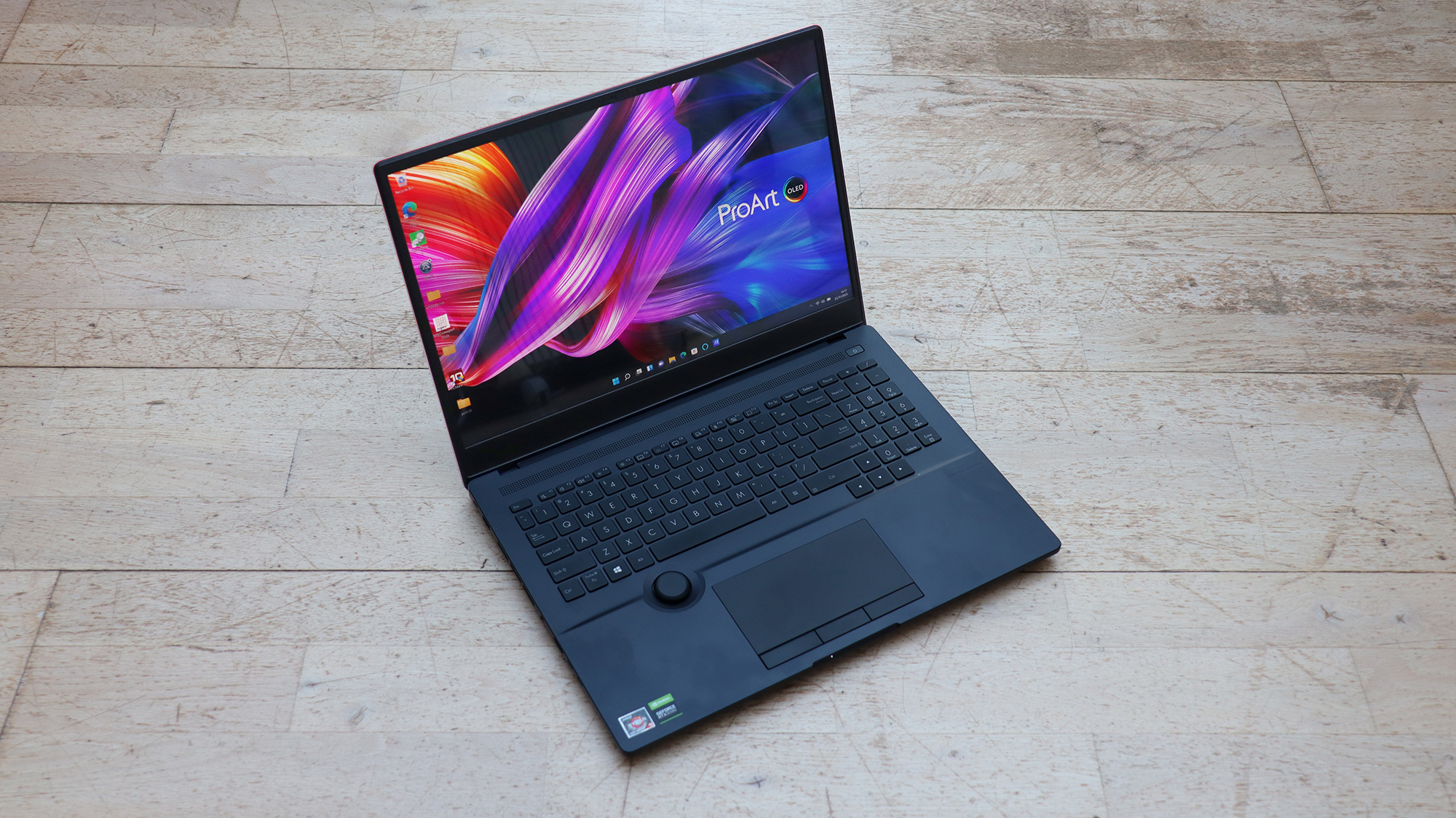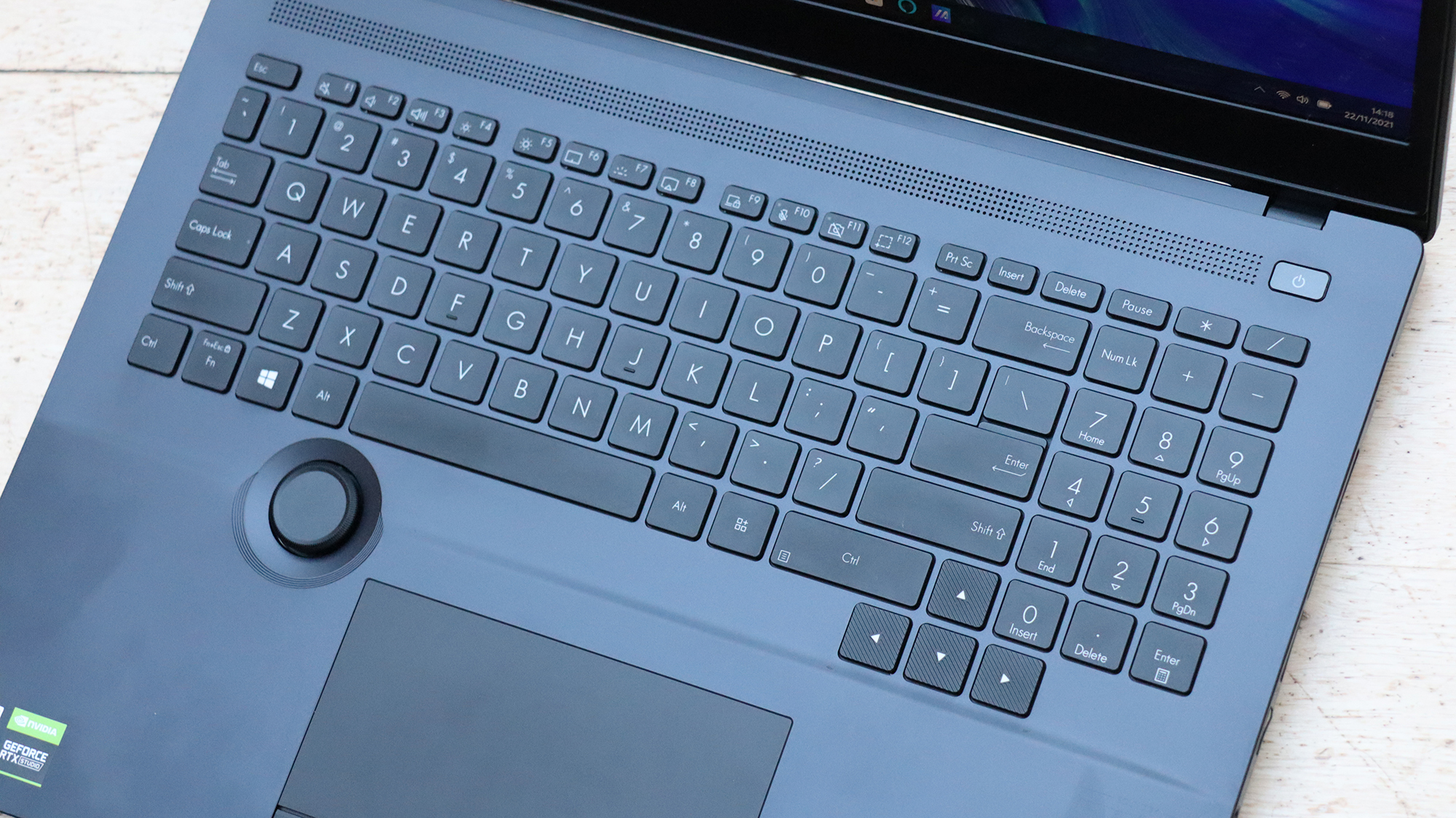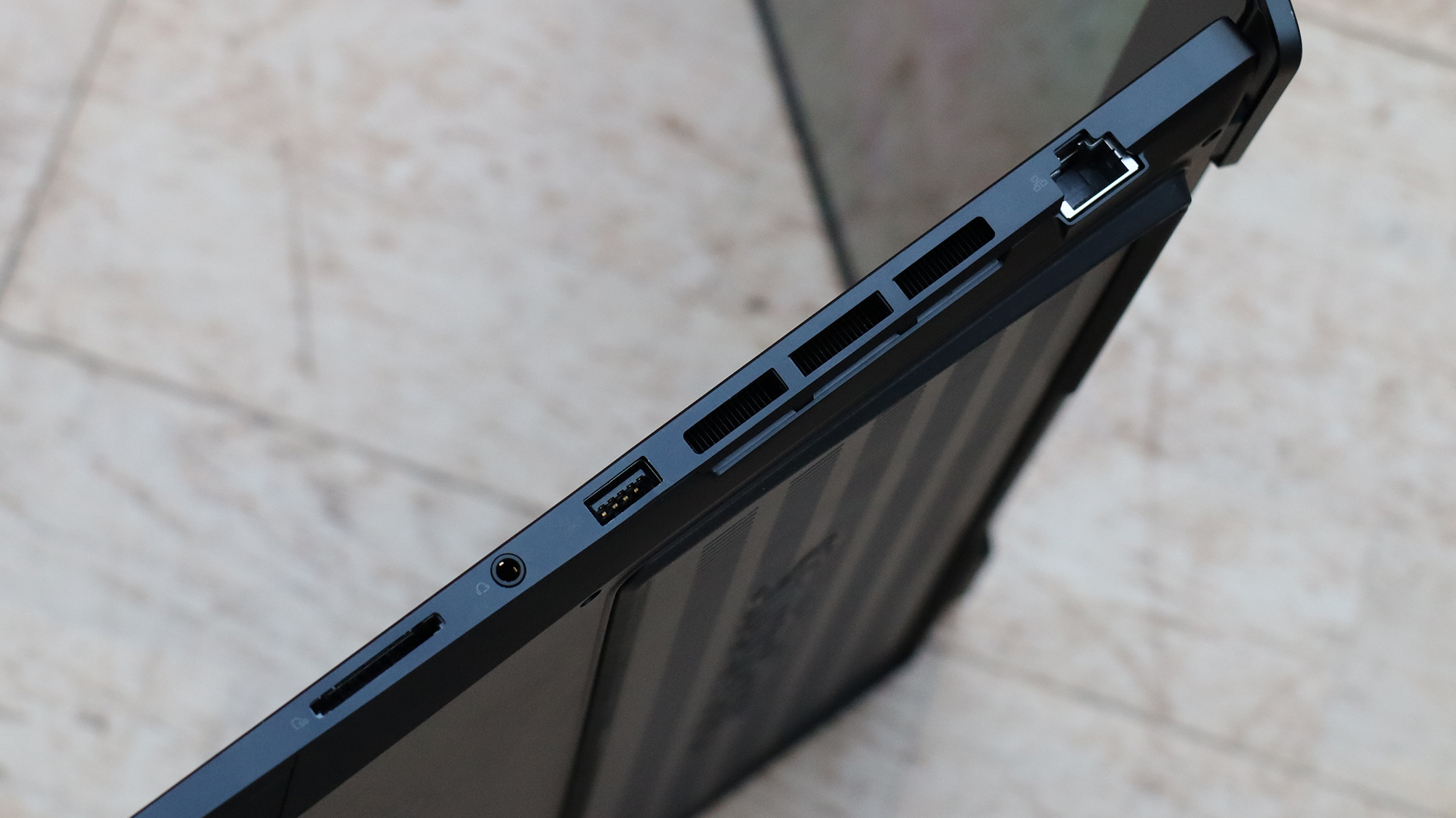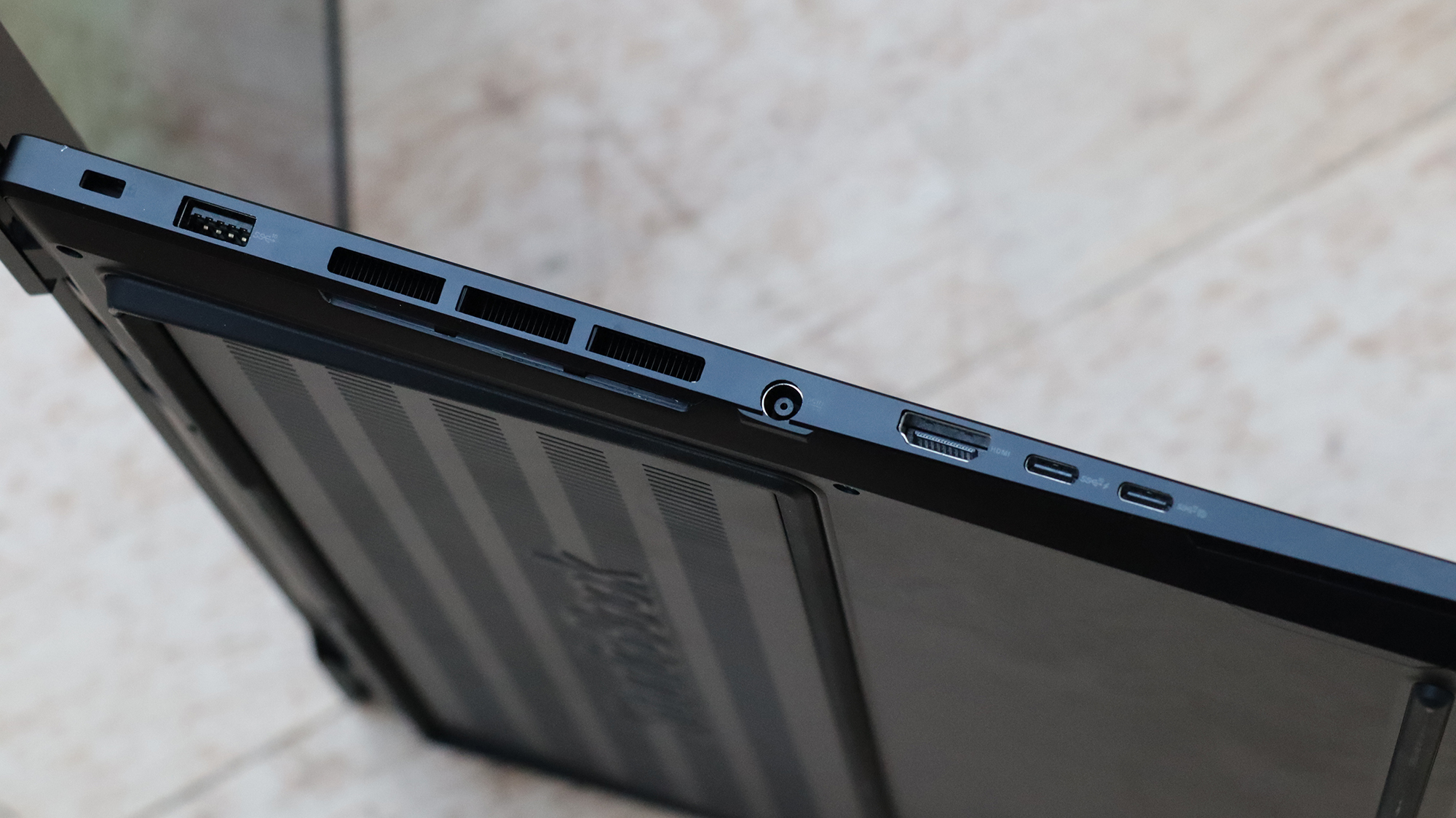Asus ProArt Studiobook Pro 16 OLED review: Serious processing and an awesome screen on the move
The first 4K 16in OLED notebook packs a performance punch and lasts surprisingly well on battery only


-
+
Superb 4K OLED screen
-
-
Consumer-grade graphics only good for some professional software
-
-
Not cheap
-
-
On the heavy side

Being creative doesn’t always happen when you’re sitting at your desk in your studio, and sometimes you need to be able to get some serious work done on the move. Mobile workstations can never quite deliver the same abilities as the tower variety, but they get closer every year, and with the ProArt Studiobook Pro 16 OLED, Asus is hoping to reduce the gap even further.
Combining a choice of high-end AMD Ryzen 5000 series processors, powerful discrete graphics, 16in screen with 4K resolution, up to 32GB of RAM and 4TB of storage, there isn’t much to separate this portable from a desktop. Prices start at £1,666.66 exc VAT, which isn’t cheap, but there’s a lot of computing here for the money.
Asus ProArt Studiobook Pro 16 OLED review: Design
Although the 16in screen format isn’t the biggest you can get in a laptop, this is still a hefty device. It weighs in at 2.4kg, which is definitely not “keep it in your backpack at all times” territory. But it’s also not as chunky and unwieldy as some of the biggest desktop replacements we’ve tried in the past, measuring just 21.4mm at its widest point, and the power brick isn’t as large and heavy as some notebooks in this class. The ProArt is still a laptop, and not just an all-in-one you can fit in a bag.
The black plastic finish is serious and business-like, but the styling is a little more funky than pure office-focused notebooks with a ridge between the keyboard and trackpad plus an extra rotating knob, which we will discuss shortly.
Asus ProArt Studiobook Pro 16 OLED review: Display
As the OLED in the name of this notebook implies, this notebook comes with a cutting-edge display. It’s 16in, but is 4K in resolution, and not just standard 4K either. The full pixel resolution is 3,840 x 2,400, meaning a 16:10 aspect ratio - and every inch is gorgeous. In our tests, this screen covered 99% of the DCI-P3 colour gamut and 96% of the sRGB colour space, with a maximum Delta-E of 0.76 making it essentially flawless. Even the brightness, which we clocked at a maximum of 399cd/m2, is more than enough for working at home, in the office or on the move.

There are two versions of this display to choose from, but the only difference between them is that one has TÜV Rheinland certification, which means it has been tested as providing less harmful blue light. Either way, this is a very lush notebook display. The colours are extremely rich with immense detail and clarity. The surface is quite glossy but without strong lighting from the environment, the viewing angles are excellent, which will be very useful if demonstrating to clients, albeit not so good for keeping your work secret on a train. In short, for those that want professional-grade image quality for sensitive media work, this screen delivers in spades.
Asus ProArt Studiobook Pro 16 OLED review: Keyboard and trackpad
The 16in 16:10 aspect screen means that this notebook is a little deeper than some, placing the keyboard further back with a larger than normal space for resting your wrists. The keys are quite shallow but have a noticeable action that makes touch-typing easy enough. The width of this notebook has also allowed room for a discrete numerical keypad on the right.
The trackpad is large and, unusually, has three buttons. The action is accurate, but the trackpad is placed centrally, which looks symmetrical but means the heel of your right hand may brush it accidentally when you’re touch typing. It’s a minor annoyance, but we really would have preferred it to be an inch or two further left.
Asus ProArt Studiobook Pro 16 OLED review: Performance
There are three processor choices with the Asus ProArt Studiobook Pro 16 OLED, but they’re all potent. The ‘entry level’ is a six-core AMD Ryzen 5 5600H, which runs at up to 4.2GHz. Alternatively, you can specify an eight-core AMD Ryzen 7 5800H, which runs at up to 4.4GHz. However, our sample came with the top choice, an eight-core AMD Ryzen 9 5900HX running at up to 4.6GHz, which is pretty insane for a portable device. Memory options range from 16 to 64GB of DDR4, with our sample having 32GB. There are three graphics choices, all of them discrete and supplied from NVIDIA, which is perhaps a bit of a surprise given the AMD processor. That does provide built-in Vega 7 graphics, which will be handy when operating on battery doing less graphics-intensive tasks.
The three GPU choices are all from the NVIDIA GeForce RTX series, ranging from a 3050Ti with 4GB GDDR6, to a 3060 with 6GB GDDR6, to the 3070 in our sample, which comes equipped with 8GB GDDR6. There are lots of storage options, starting with a single 512GB M.2 NVMe PCI Express 3.0 SSD and going up to a pair of 2TB drives with the same interface. Our sample came with a 2TB capacity - plenty for apps and media. Using CrystalDiskMark 8, this drive delivered a very healthy 5,760MB/sec sustained reading and 5,999MB/sec sustained writing.

This notebook is meant to get close to workstation performance, so we ran a subset of the benchmarks we deploy on professional content creation desktops. Our regular benchmarks delivered an impressive overall score of 234, with a particularly strong image editing result of 212, 128 in video editing, and 173 in multi-tasking. These aren’t the fastest we’ve seen in a laptop, but still highly commendable. The Maxon Cinebench R20 render test delivered a score of 4,776, which is about half what a 16-core desktop workstation would deliver (unsurprisingly) but shows that if you’re rendering out 3D work on CPU, this notebook is no slouch.
You buy a notebook like this more for the design stage than rendering out, though, so we ran SPECviewperf 2020 to see how it coped with a broad set of 3D content creation applications. We ran the V1.0 version because V2.0 introduces a new viewset version so can’t be compared to previous tests we have run. The ProArt does have extremely powerful graphics for a notebook, but the GeForce is a consumer-grade GPU and that has some drawbacks for professional 3D software.
The 3dsmax-07 score of 77.42 is good enough, and 240.1 in maya-06 is incredible. The graphics also delivered a very commendable 171.69 in solidworks-05. In other words, Autodesk 3ds Max or Maya 3D animation, and SolidWorks product design, will be great. But 17.77 in catia-06 and 18.8 in snx-04 show that these two engineering CAD apps won’t be so smooth to work with, as we always find with non-professional GPUs.
Asus ProArt Studiobook Pro 16 OLED review: Battery life
Battery life is normally the area where larger notebooks fall down, as higher processing power means higher energy consumption. Not so the ProArt: it lasted 6hs 19mins in our video playback battery test. It backed that up in day-to-day use too, giving us the best part of six hours for day-to-day tasks.
Sure, we’ve seen notebooks like the Samsung Galaxy Book Pro 15.6in manage close to 14 hours of usage, and Apple M1-based notebooks can go even longer, while the Asus ExpertBook B94550F lasted over 22 hours when we reviewed it. But the ProArt is supposed to be vying with your desktop PC for power, so the fact that it can give you the best part of a day on battery means you could feasibly use it on a train or flight for serious work - and that’s impressive. Do bear in mind, however, that any hardware-intensive work like video rendering will place more of a strain on that battery life.

Asus ProArt Studiobook Pro 16 OLED review: Ports and features
One of the advantages of larger notebooks is usually that they have more space for ports, and the ProArt is well endowed in this respect. On the left is a USB 3.2 Gen2 Type A port, the input for the power brick, and a full-sized HDMI 2.1 port, supporting 8K and 120Hz. Next to this is a pair of USB 3.2 Gen2 Type C ports, which offer power output so could drive displays on their own.
The funkiest element of all is the rotating knob to the top left of the trackpad. This “Asus Dial” provides rapid access to screen brightness and speaker volume, but it can also be configured to access other shortcuts via the Asus ProArt Creator Hub software and is compatible with Adobe apps. For example, you can use it with recent versions of Photoshop to quickly change things like brush sizes.
On the right is a Gigabit Ethernet port, and another USB 3.2 Type A port, then a combo minijack for headphones and microphone. Finally, there is a full-sized SD card slot which supports SD Express 7.0, so with the right card can deliver throughput of 985MB/sec. These cards are NVMe-based and are basically an SSD in SD card format. Some vendors have launched products already, but they are not currently listed in any online shops.
The HD webcam on the top of the bezel has a physical privacy shutter you can move across to block it.
Asus ProArt Studiobook Pro 16 OLED review: Verdict
The Asus ProArt Studiobook Pro 16 OLED bucks the trend somewhat with notebooks in this class. It is still quite big and heavy, but not so huge that you won’t want to take it with you on a journey. The screen is superb, and the eight-core AMD Ryzen 9 processor is hugely powerful. You also get immensely potent NVIDIA GeForce RTX 3070 graphics.
Perhaps the most surprising thing is how long this notebook lasts on its battery. This means the Asus ProArt Studiobook Pro 16 OLED is a powerful content creation notebook you can use on the move for extended periods, making it a great choice for graphics professionals who need to take their work with them on a regular basis.
Asus ProArt Studiobook Pro 16 OLED specifications
| Processor | AMD Ryzen 9 5900HX running at up to 4.6GHz |
| RAM | 2 x 16GB LPDDR4 |
| Graphics | AMD Radeon Vega 7 + NVIDIA GeForce RTX 3070 with 8GB GDDR6 memory |
| Storage | 2TB NVMe PCI Express 3.0 SSD |
| Display | 16in 3,840 x 2,400 OLED |
| Operating system | Windows 11 Pro 64-bit |
| Connectivity | Dual-band 802.11ax WiFi, Bluetooth 5.1 |
| Ports | 2 x USB 3.2 Gen 2 Type-C, 2 x USB 3.2 Gen 2 Type-A, 1 x HDMI 2.1, 1 x 3.5mm combo audio, 1 x LAN, SD Express 7.0 |
| Dimensions | 362 x 264 x 19.9-21.4mm (WxDxH) |
| Weight | 2.4kg |
| Warranty | 3yr RTB |
Get the ITPro daily newsletter
Sign up today and you will receive a free copy of our Future Focus 2025 report - the leading guidance on AI, cybersecurity and other IT challenges as per 700+ senior executives
Dr James Morris has worked as a technology journalist for over 25 years, including spending nine years on the staff of market-leading computer magazine PC Pro, the last five of which were as the publication’s editor. He specialises in enterprise-grade software and hardware, with a particular focus on content creation. He launched a pioneering video channel for HEXUS.net in 2006 and ran the video reviews channel for TrustedReviews.com for four years. He also runs a successful online digital content and commercial video production company, t-zero communications Ltd.
Dr Morris is a prolific technology writer and contributes commercial content for major IT brands including AMD, BlackBerry, Dell, Cognizant, HP, and IBM. He published a book on artificial intelligence, Can Computers Create Art? in 2009. He is also an academic, and is currently Pathway Director of the MA, Interactive Journalism at City, University of London.
Previously, he was course leader for the BA in Web Media Production at Ravensbourne University. He has a PhD in Philosophy, Art and Social Thought from the European Graduate School in Switzerland, a Master's in Media Arts from the New School in New York, USA, and a Bachelor's in Social Anthropology from the London School of Economics.
Dr. Morris can be found on Twitter at @Cyberwest, or emailed at j@tzero.co.uk
-
 Colt Technology sells eight European data centers
Colt Technology sells eight European data centersNews NorthC says the acquisition will help it improve coverage in Germany and other markets
By Emma Woollacott Published
-
 SYSPRO names Leanne Taylor as chief revenue officer
SYSPRO names Leanne Taylor as chief revenue officerNews The experienced executive will lead the firm’s revenue strategy as it looks to drive global growth
By Daniel Todd Published
-
 Intune flaw pushed Windows 11 upgrades on blocked devices
Intune flaw pushed Windows 11 upgrades on blocked devicesNews Microsoft is working on a solution after Intune upgraded devices contrary to policies
By Nicole Kobie Published